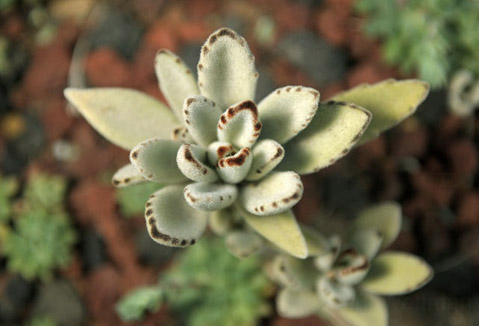A Slew of Succulents
The Kalanchoe Genus Offers a Multitude of Drought-Tolerant Species

The diversity of plant life is quite amazing. The something like 300,000 plant types on the earth have evolved from some single-celled algae to everything from giant redwood trees to lacy ferns. What is really astounding is when within a very closely related group of plants, say species in the very same genus, there can be so much variation in plant form.
The genus Kalanchoe is one such group. From smallest to largest, there are a multitude of succulent and thus drought-tolerant species to choose from. One of the smallest in stature is only 8-12 inches tall and has an equally dainty name—the flower dust plant (K. pumila). The small dark green leaves are dusted with a whitish powder, giving the whole plant a ghostly hue. For several months in late winter and early spring, the plant disappears beneath a multitude of pink flowers. It is useful for the edge of the bed or in containers.
Another species that blooms in a pretty showy way also has sculptural good looks year-round. K. fedtschenkoi has short stems, usually no higher than a foot, that sport succulent leaves with scalloped edges in shades of gray-green shading to pink (yes, pink!). The leaves tend to all line up in the same direction parallel to the stem and facing the source of the brightest light. When in bloom, the graceful flower stalks rise up from the apex of the stems and also tend to curve all in the same direction while dangling dusty-pink bell-shaped flowers.
Some other species are not especially noted for their flowers, but the colors and patterns on their leaves are worth a second look. The most charming of these is the panda plant (K. tomentosa). It has slender stems supporting a few narrow fleshy leaves that are covered in short, thick hairs. The gray-green, slightly notched leaves are edged in dark brown. Very cute, just like a real panda.
The larger species are equally enchanting. Kalanchoe beharensis is the giant among them. Sometimes known as the felt plant, the leaves of this species are covered with what can only be compared to the flocking on a cheap plastic toy bear. They are of an ornamental and intricate shape, as well—sort of an arrowhead shape that is partially folded with an irregularly wavy edge. Just a handful of these leaves will top a thick succulent stem that can be up to six feet tall in an old, lucky plant. The other show-stopper is K. luciae, also known as the paddle plant because it looks like a bouquet of ping pong paddles stuck in the ground. In bright light and cold winter temps, the paddle-shaped leaves take on a deep flame-orange color shading to the palest green at the base. The plants will slowly increase in size by growing separate basal suckers, eventually reaching a couple of feet in diameter.
Celebrate diversity wherever it is found. In the dry garden, it could be with a kalanchoe or two.
March Tips
• Don’t panic if your oak trees have been defoliated (or nearly so) by the seasonal attack of oak moth caterpillars. The offending insects will soon die on their own or be picked off by birds, and the oaks will grow another set of leaves. If rains hold off, consider giving them a deep irrigation while temperatures are still cool to give the trees a better chance of recovery.
• That goes for other plants, especially trees, this so-far-unrainy season. Regular irrigation is still needed. Monitor soil moisture, and water as necessary.
• Check mulch levels, renewing to a depth of a minimum of four inches.



